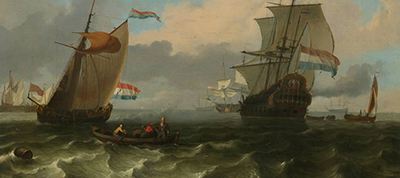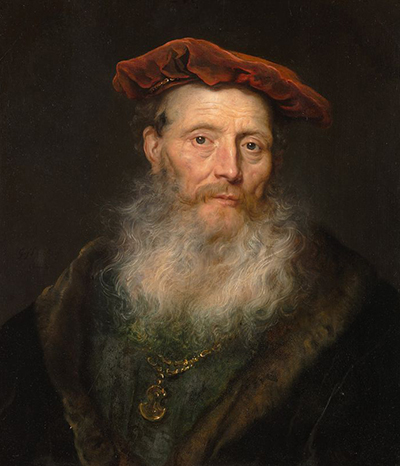The Dutch Golden Age was a prominent time in the Netherland's history where the nation seized the world as a superpower in trade, science, military, economics, and art.
The period began during the early 17th century and had laid a prominent foundation for an array of Dutch artists to a rise. The painting captured here is Bearded Man with a Velvet Cap by Govert Flinck.
The Transition
Through an upscale shift in population throughout the nation due to war and a sharp break in Christian religious traditions, the social structure of the Netherlands began to change.
Due to the national transition, Dutch art had to continue in the footsteps and reshape itself as well.
Religious painting began a decline, common everyday event were depicted much more, and thought provoking subject matters grew. The Dutch Golden age is included in the much larger Baroque painting era of Europe.
These painting were commonly based of elaborate realist work that showcased love, drama, and violence. Most of the style showcased throughout the Baroque era originated from the early stages of the Dutch Golden Age.
Upon entering the 1620's of the Dutch Golden Age, many artists believed that they must break off into a specific specialization in order to showcase their skill.
Many focused only on portraits, genre painting, landscapes, still life, or other popular scenes of the time. Branching off into these specific sections was a critical element for the artists to develop their own style and was far more advances than western art.
Historical Paintings
Historical paintings were the first popular genre that entered the golden age as their familiarity was welcomed. The paintings did not only depict historical events but as well coveted stories from mythology, religion, literary, and allegorical stories.
The historical events during the time that were recent were treated as realist fashion addressing the events in an education form as it may had been the only way to depict what had occurred other than writing.
While religion was still a focal point that was popularly discussed, the production of religion within paintings decreased. Many Dutch painters decided to continue the Italian tradition of illustrating a classic technique and style. Prints and similar paintings to classic Italian masterpieces circled the nation as artists attempted to compete with the classic works of Caravaggio and Leonardo Di Vinci.
Compared to the classic Baroque style of Italian painters, the Dutch preferred to alter their work towards realism instead. While nudity was a classic component illustrated throughout the renaissance paintings, genre paintings within the Dutch Golden Age preferred a conservative route and only depicted limited sexuality when portraying the female body.
Artists commonly only showcased a glimpse view of breasts or thigh within their work and was most commonly done only when depicting prostitutes or a provocative nature.
Prominent Dutch artists during the time include Gerard De Lairesse, Pieter Lastman, and Govert Flinck who based an array of their work on history paintings.
Portraits
The use of portraits within art is a popular style as they are able to depict the essence of humans. Portrait painting gain impeccable commonality throughout the 17th century through the wealthy upper class who commissioned artists for portraits.
It is predicted that roughly 750,000 to 1,100,000 were produced in the Netherlands during the Dutch Golden Age. The production of portraits for an artist was not only a brilliant manifestation of their skill and knowledge, but also a viable way to earn money at the time.
Popular portraits that were produced by Dutch artists highly focused on a classical style rather than elaborate decoration and clothing. Artist Bartholomeus Van Der Helst often enjoyed depicting the wealthy upper class in a classic outfit to accentuate their natural features. These portraits often included the upper section of ones body alongside their face, including a full body paintings as it might show pride and arrogance. Portraits were often painted upon marriage to depict the unity between husband and wife.
The other prominent portraitist during the era was Frans Hals whose lively brush stroke held the ability to show his muses as cheerful and relaxed. These portraits are believed to had been painting during a sitting or two in which the muse was required to sit for a long period of time while the artist showcased them.
The artists often depicted their muses in clothing altered from what they were actually wearing in order to ignore the difficult task of having to illustrate the material and texture in that exact detail. Lace and ruffles were incredibly time consuming to portray however were unavoidable as the intercut detail was highly desired by the customer.
Towards the end of the era, portraits began to transition towards elaborate designs in clothing. Magnificent artist Johannes Vermeer often enjoyed showcasing his models in vibrant dresses and detail adding to the luxury of the woman. The type of clothing portrayed within the artwork often suggested the social status of the individual being depicted.
Vermeer commonly enjoyed showcasing a bright yellow dress with white fur sleeves and collars in order to illustrate the wealthy status of the muse. This common outfit throughout his work is depicted within Woman With a Pearl Necklace, A Lady Writing, Mistress and Maid, and an array of others.
Family portrait photos were often painted as well showcasing the rich and powerful status of a family. These were often depicted in an outdoor setting to allow more room and included elements within the setting to aid to the painting. Much attention was paid to small detail throughout these grand portraits.
Each member within the group often paid for the portrait, however not equally. The amount one paid would often showcase their position within the painting or the extent of detail that would be used on them.
Scenes of Everyday Life
One of the most popular genres of art during the era were paintings depicting scenes from everyday life. These paintings often had no specific identify attached and were based on the orders of the artist themselves. These genre paintings often depicted large groups or small individual paintings showcasing the classic lifestyle at the time.
While these artworks commonly depicted the everyday life of the Dutch society, not all paintings are factual illustrations of what occurred during the time. Some of these paintings were based on mythical stories that were passed down rather than exact events that occurred. As well many were staged in order to aid in the artist's production of the work.
Artist Jan Steen was a classic painter who enjoyed depicting elaborate scenes from everyday life. His work was often realistically depicted showcasing an array of colour and texture throughout his work adding to the piece.
Landscapes and Cityscapes
Outdoor artistry was a popular art form painters clang to as their imagination aided in the work. The Dutch Golden Age had developed its own style in depicting landscape paintings based on lower horizontal levels to place emphasis on the ground. The setting the artwork was often out in nature showing the cold climate and region of the nation.
Some of the favourite subject lines of painters to depict include rivers, meadows, cattle, and forests. The sea was one of the most popular themes presented as the mysterious unknown always seized the viewers.
Significant Dutch artist who has showcased the landscape paintings were Esaises Van De Velde, Hendrich Avercamp, Jan Van Goyen, Salomon Van Ruysdael, and Pieter de Molyn.
Maritime Painting

Based on the nation's location near the sea, the grand body of water brought the nation wealth and protection. However, many parts of it remained unknown and mysterious.
Artists commonly enjoyed portraying these images with ships at bay, boats sailing into the horizon with docks empty. The citizenÕs strong relationship with water was depicted within the artwork as artist's illustrated these imagery.
Still Life
The Dutch Golden Age showcased a shift in style as artists intertwined other elements within their artwork such as still life paintings. These artworks commonly included an array of goods placed nicely together while the artist painted them. A realist technique was often used while illustrating these objects as it enabled the painter a chance to showcase their attention to detail and personal skill.
These still life paintings often included a classic theme that travelled throughout the work such as food, flowers, table settings, or vanities. These imagery often held an array of symbolism manifested by the artist, for example wilted roses often represented death and heartbreak, while the table top of a work desk symbolised knowledge.
Deep dark colours are often used throughout the artwork in order to illustrate the emotion of the piece. Dark browns, burnt orange, teal blues and an array of greys are common colours used throughout the art.
Foreign Lands
As the Netherlands was surrounded by sea, artists often depicted their desires and items in which they longed for. An array of artists during the Dutch golden age depicted foreign exotic lands based on their personal understanding of the environment.
The enormous array of success held by artists within the Dutch Golden Age paved the way for artists to find their own style of art. Many future artists had become inspired from the period in Netherland's history where the economic and political dominance was accompanied by social and artist change.
The courage of artists to enter into an unknown field of art granted the era to be known as one of the most classic periods in art history.
Painters were able to incorporate classic techniques and styles from prior periods and intertwine them within their work. Johannes Vermeer was successful in finding his own position within the Dutch Golden Age, alongside earning his the title of a revolutionary artist who paved the way for others behind him.




